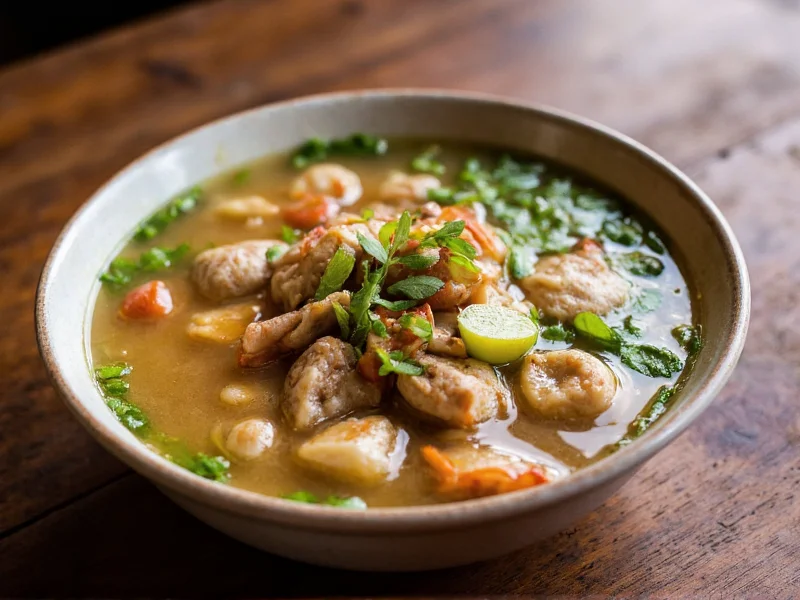As Vietnam's national dish with global popularity, pho represents more than just sustenance—it's a cultural institution with deep historical roots. The magic of authentic pho lies in its meticulously crafted broth, which requires patience and precision to develop its signature clear yet deeply flavorful profile. Unlike ordinary noodle soups, genuine pho balances five fundamental tastes: savory, sweet, sour, bitter, and umami, creating a harmonious culinary experience.
The Essential Components of Authentic Pho
Every proper bowl of pho contains four critical elements working in concert:
- Broth – The soul of pho, simmered 6-12 hours with beef or chicken bones, charred onion and ginger, and a spice bouquet typically including star anise, cloves, cinnamon, and cardamom
- Rice Noodles (Bánh phở) – Flat, silky rice noodles that maintain texture when submerged in hot broth
- Protein – Most commonly thinly sliced beef (brisket, flank, or rare steak) or chicken, though vegetarian versions exist
- Herb Garnish Plate – Fresh basil, cilantro, sliced onions, bean sprouts, lime wedges, and chili peppers for customization
Historical Origins of Pho Soup
Pho emerged in northern Vietnam during the early 20th century, likely influenced by both French colonialism (introducing beef consumption) and Chinese noodle traditions. The name possibly derives from “phồ” ( Vietnamese for “noodle soup”) or the French “pot-au-feu” (stew). Originally street food for laborers, pho gained nationwide popularity after the 1954 partition when northern refugees brought it to southern Vietnam, where it evolved with sweeter broths and more herb varieties.
Regional Variations Across Vietnam
Understanding the difference between northern and southern pho styles reveals Vietnam's culinary diversity:
| Characteristic | Northern Pho (Phồ Hà Nội) | Southern Pho (Phồ Sài Gòn) | h>
|---|---|---|
| Broth Flavor | Clean, subtle, less sweet | Sweeter, more robust |
| Herbs | Limited—primarily cilantro and green onion | Abundant—basil, bean sprouts, culantro, lime |
| Noodle Width | Wider noodles | Narrower noodles |
| Condiments | Fish sauce, chili | Hoisin sauce, Sriracha |
| Meat Portions | More meat, less broth | More broth, less meat |
How to Experience Pho Authentically
Traditional pho consumption follows specific customs that enhance the experience. In Vietnam, pho is typically eaten for breakfast, with locals often standing at street stalls. The proper technique involves:
- First, smell the aromatic broth to appreciate its complexity
- Add desired garnishes directly to the bowl (not on the side)
- Use chopsticks in your right hand and a soup spoon in your left
- Combine noodles, meat, and herbs with each spoonful of broth
- Never mix all ingredients thoroughly—each bite should offer varying combinations
Pho's Global Journey and Cultural Significance
Following the Vietnam War, refugees introduced pho to North America, where it gradually transformed from an ethnic specialty to mainstream cuisine. Today, authentic pho restaurants exist worldwide, though quality varies dramatically. The dish's global appeal stems from its comforting warmth, customizable nature, and the therapeutic qualities of its nutrient-rich broth—qualities that explain why many consider pho the ultimate healing food.
Unlike instant ramen or other quick noodle dishes, genuine pho represents culinary craftsmanship. The time-intensive broth preparation—skimming impurities for hours to achieve crystal clarity—demonstrates why mass-produced versions rarely capture authentic pho's essence. When prepared traditionally, pho delivers not just nourishment but a multisensory experience connecting diners to Vietnamese heritage.
Common Misconceptions About Pho Soup
Several myths persist about this beloved dish. Many believe pho is simply “Vietnamese ramen,” but the two dishes have distinct origins, ingredients, and preparation methods. Others assume all pho contains hoisin sauce, though northern Vietnamese traditionally disdain this southern addition. Additionally, while Western restaurants often serve pho with excessive meat portions, authentic versions feature modest protein quantities balanced by generous broth.
Pho Compared to Other Asian Noodle Soups
Though often grouped with other Asian noodle soups, pho has distinctive characteristics:
- Ramen (Japan)—Uses wheat noodles in pork or chicken broth with miso or soy seasoning; features thicker, chewier noodles
- Udon (Japan)—Thick wheat noodles in mild dashi broth; less complex seasoning than pho
- Bun Bo Hue (Vietnam)—Spicier, lemongrass-forward broth with round rice noodles; originates from central Vietnam
- Khao Soi (Thailand)—Curry-based soup with egg noodles; features coconut milk and distinct Thai flavors
What sets pho apart is its delicate balance of spices without overpowering heat, the use of rice noodles instead of wheat, and the emphasis on clear, refined broth rather than creamy or coconut-based preparations.
Frequently Asked Questions About Pho Soup
What is the correct pronunciation of 'pho'?
Pho is pronounced "fuh" (rhymes with "duh"), with a short, flat tone. The common mispronunciation "foe" comes from English speakers unfamiliar with Vietnamese tones.
Is pho gluten-free?
Traditional pho is naturally gluten-free as it uses rice noodles and a broth without wheat products. However, some restaurants add soy sauce (which contains wheat) or serve hoisin sauce (often wheat-based) as condiments, so always verify ingredients if you have gluten sensitivity.
How does pho differ from other Vietnamese noodle dishes?
Pho specifically refers to the rice noodle soup with clear broth flavored with charred aromatics and spices. Other Vietnamese noodle dishes like bun cha (grilled pork with vermicelli) or bun bo hue (spicy lemongrass soup) have different broths, noodles, and flavor profiles that distinguish them from traditional pho.
Why is the broth in pho so clear despite long simmering?
The clarity comes from careful preparation techniques: blanching bones first to remove impurities, maintaining a gentle simmer (not boil), and constant skimming of foam. Authentic pho broth never becomes cloudy when prepared correctly, unlike many Western bone broths that intentionally create emulsification.
Can pho be made vegetarian or vegan?
Yes, vegetarian and vegan pho exists (phồ chay), using mushroom or vegetable broth instead of meat-based stock. The key is replicating the umami depth through ingredients like roasted mushrooms, soy sauce, and additional spices to compensate for the absence of meat bones.











 浙公网安备
33010002000092号
浙公网安备
33010002000092号 浙B2-20120091-4
浙B2-20120091-4